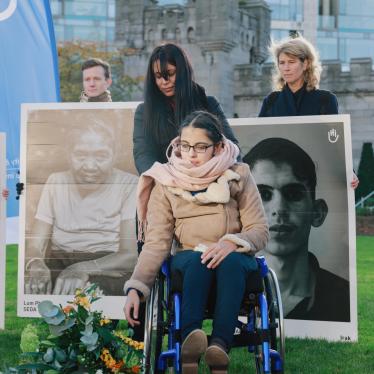The past year underscored the need to have and to ensure respect for strong and effective humanitarian disarmament law. Since Russia’s full-scale invasion of Ukraine, cluster munitions, antipersonnel landmines, and explosive weapons with wide area effects have been used in populated areas, mostly by Russia. Russia has in addition repeatedly threatened to use nuclear weapons.
These attacks and threats have inflicted a horrific civilian toll, but they have also generated international opprobrium because they involved weapons banned or practices restricted under humanitarian disarmament treaties and commitments. While more work needs to be done to minimize the civilian suffering in Ukraine and other armed conflicts around the world, demonstrating robust and united support for global civilian protection norms is an important step.
Humanitarian disarmament, which seeks to prevent and remediate arms-inflicted human and environmental harm, was advanced as well as reinforced in 2022. States adopted important new standards and commitments on the use of explosive weapons in populated areas, nuclear weapons, and the environment and armed conflict. To ensure that these standards and commitments achieve their potential, 2023 will be critical for implementation. It is also a time for innovation, especially in addressing the risks and dangers posed by autonomous weapons systems.
Explosive Weapons in Populated Areas
A political declaration on the use of explosive weapons in populated areas, endorsed by 83 countries on November 18, aims to better protect civilians from humanitarian consequences of the bombing and shelling of cities and towns. It goes beyond urging greater compliance with existing international humanitarian law to establishing guidelines for preventing and remediating the harm from this method of warfare. The use of explosive weapons in populated areas is one of the greatest threats to civilians in contemporary armed conflicts, and the declaration contains strong provisions with the potential to address both direct and reverberating effects. But it will only be as effective as its interpretation and implementation.
Over the next year, signatories to the declaration should ensure that they interpret it through a humanitarian lens. Its core provision calls on states to adopt “policies and practices to help avoid civilian harm, including by restricting or refraining as appropriate from the use of explosive weapons in populated areas, when their use may be expected to cause harm to civilians or civilian objects.” According to a report by Human Rights Watch and Harvard Law School’s International Human Rights Clinic, to live up to the declaration’s humanitarian purpose, states should understand the paragraph to mean they should refrain from using explosive weapons with wide area effects in populated areas, and restrict their use of all other explosive weapons in those areas.
State signatories should also carry out the commitments they made in the declaration and be ready to report on their progress at the first follow-up meeting in Norway in 2024. They should, for example, review, develop, and improve relevant national policies and practices; train their armed forces on the declaration’s provisions; collect and share data; and provide assistance to victims. Several civil society organizations have published recommendations for how most effectively to implement the declaration’s commitments.
Nuclear Weapons
Implementation is also key for the 2017 Treaty on the Prohibition of Nuclear Weapons. The treaty’s landmark First Meeting of States Parties in Vienna last June adopted the Vienna Declaration, reaffirming states parties’ commitment to eliminating nuclear weapons and stressing the treaty’s underlying moral and ethical imperatives. The meeting further agreed to the Vienna Action Plan, which lays out steps to advance the process of implementing the treaty. Expanding support for the treaty remains a top priority. Five years after its initial signing conference, the treaty has 68 states parties and an additional 27 states have signed.
Another area of focus is the positive obligations to assist victims, remediate environmental contamination, and provide international cooperation and assistance. The Action Plan identifies initial steps states parties should take to establish an implementation framework. They should assess the harm caused by nuclear weapons use and testing and their capacity to address it, develop a national plan with a budget and time frame, establish a government “focal point” to guide these efforts, and adopt relevant laws and policies. In addition, they should follow principles of accessibility, inclusivity, non-discrimination, and transparency at all stages of carrying out these obligations.
Environment and Armed Conflict
New standards were set during the past year with regard to the environment and armed conflict. On December 7, the United Nations General Assembly adopted by consensus the International Law Commission’s Principles on the Protection of the Environment in Relation to Armed Conflicts. The non-binding principles cover situations before, during, and after times of armed conflict.
The principles call for designating protected zones, explicitly applying existing international humanitarian law to the environment, and laying out rules to protect the environment during times of occupation. They also underscore the importance of cooperation in developing post-conflict remedial measures.
The Conflict and Environment Observatory, which advocated heavily for the principles, said that, “The UN General Assembly’s adoption of the principles and their commentaries represents the transition point between [the principles’] development and the beginning of its implementation phase.” Early steps in this stage include raising awareness about the principles and adopting national measures, such as training armed forces on their content.
Autonomous Weapons Systems
While the new standards and commitments on explosive weapons, nuclear weapons, and the environment in armed conflict require implementation, the dangers raised by autonomous weapons systems are still not constrained by specific legal rules. Innovation will, therefore, be crucial in 2023. International talks at the Convention on Conventional Weapons (CCW) have been ongoing since May 2014, but no action has been taken. At the CCW’s annual meeting in November, states parties yet again failed to make any meaningful progress despite calls from a majority of states parties, plus the International Committee of the Red Cross and civil society organizations, to open negotiations for a new treaty to prohibit and regulate autonomous weapons.
Due in large part to the CCW’s reliance on consensus-based decision making, however, states parties could only agree to discuss—for the tenth year—“possible measures” for addressing the myriad threats such weapons systems pose. States parties will need to break out of the CCW if they want to make progress toward a new instrument on autonomous weapons systems.
States need to innovate by changing their tactics for achieving a treaty, and there is ample precedent for taking a different approach. Existing disarmament treaties offer models for successfully adopting legal instruments in alternative forums. As discussed in a recent report by Human Rights Watch and Harvard Law School’s International Human Rights Clinic, states could turn to an independent process outside the UN, as was done for the Mine Ban Treaty and Convention on Cluster Munitions. Or they could initiate a UN General Assembly process, as was used for the Treaty on the Prohibition of Nuclear Weapons. Both approaches have several benefits: a common purpose, voting-based decision-making, clear and ambitious deadlines, and a commitment to inclusivity.
In 2023, Costa Rica, Luxembourg, and Austria are all planning conferences outside of the CCW on autonomy in weapons systems. States and others that support creating new law to address the moral, legal, accountability, and security concerns about this emerging technology should take advantage of these meetings to build momentum for negotiations.









